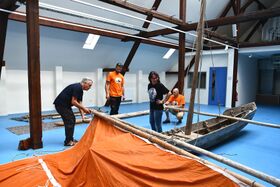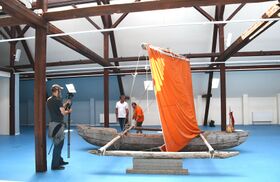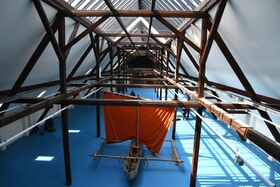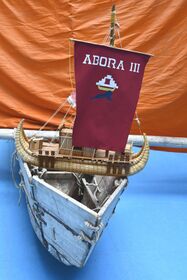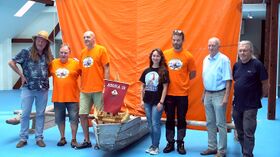ABORA-Sonderausstellung in Hoheneck nimmt Gestalt an
===Presse Release of ABORA – 08. August 2024 www.abora.eu===
Kontakt: Dr. rer. nat. Dominique Görlitz; 0049 163 511 57 66 oder dominique.goerlitz*at*t-online.de (bitte "*at*" durch *@* ersetzen, oder, sofern auf Ihrem System möglich, einfach den Link anklicken)
(dg)Der Volksmund sagt: „Was lange währt wird gut.“ Dies scheint auch im Areal Stalburc-Hoheneck (ehemals Schloss Hoheneck) in der Erzgebirgsstadt Stollberg der Fall zu sein. Nach Jahre langen Tauziehen um Fördermittel, Genehmigungen und der schwierigen bautechnischen Umsetzung ist der Grundstein für den Einzug des ABORA-Teams in das Ausstellungsareal gelegt. Die mehr als 850 m² große Ausstellungsfläche ist fertig gemalert und glänzt prächtig im Dachgeschoss des Ostflügels. Diese Woche fand die erste Begehung nach der Fertigstellung mit dem Oberbürgermeister Marcel Schmidt unter der Begleitung unseres Nuoviso-Teams aus Leipzig statt.
Mit der Errichtung des neuen ABORA Science Centers für frühgeschichtliche Seefahrt, Archäologie und Uralt-Bergbau im Areal Stalburc-Hoheneck möchte die Stadt Stollberg neue Wege gehen. Diese Themen, mit all ihren historischen, technischen und auch bergbauhistorischen Dimensionen in einer Ausstellung darzustellen, ist eine bedeutende kulturhistorische und somit auch politische Aufgabe. Diese Themen sind aber so nur unzureichend im Bewusstsein unserer Gesellschaft verankert. Durch die Bearbeitung des Beitrags der frühen Seefahrt, der Migration und des Handels zur Erkundung der Welt sowie die Entstehung des sächsisch-böhmischen Bergbaus von ihren prähistorischen Wurzeln bis hin zur Gegenwart wird das Museum einen Beitrag leisten, das sich in das bereits bestehende Tourismuskonzept „Erzgebirgsregion“ einfügen wird.
Dafür wurde das erste große Bootsmodell für diese Präsentation eigens hergerichtet, um den Zuschauern von Nuoviso und ABORA TV eine Vorstellung von dieser neuen Kulisse zu geben. Geplant sind weitere prähistorische Rekonstruktionen, die auch eine gedankliche Verbindung zu dem vor-antiken Zinnbronze-Fernhandel herstellen. Den meisten Deutschen ist nicht bewusst, welche bedeutende Rolle diese Region im Altertum für die Ausbildung und Verbreitung der Bronzemetallurgie nördlich der Alpen gespielt hat. Handelsverbindungen, die vom Baltikum über das Erzgebirge sowohl durch die Adria als auch die Ägäis führten, machten die heutige UNSECO-Kulturerberegion schon im Altertum zu einen metallurgischen Innovationszentrum. Kein Wunder also, dass der Vater der Geschichtsschreibung Herodot, dieses Gebiet als den vermeintlichen Zinnlieferanten in der Antike vermutete.
Das ABORA-Team forscht seit mehr als drei Jahrzehnten noch an vielen weiteren Themen der Altertumswissenschaften. Neben dem Bau der Pyramiden und der Verwendung von Eisen als Konstruktionsmetall bearbeitet der Kurator noch ergänzende Fachbereiche, wie die Kartographie, Astroarchäologie oder den Fernhandel mit altamerikanischen Kulturpflanzen.
All diese spannenden und noch nicht vollständig aufgeklärten Wissensgebiete werden künftig hier eine Plattform bekommen. Nicht alle Interpretationen sind von der Fachwissenschaft völlig akzeptiert. Doch genau darum geht es in der Wissenschaft. Sie sucht nicht die absolute Wahrheit, sondern stellt immer nur noch tiefgründigere Fragen. Die Rätsel der alten Zivilisationen fordern uns auf, diese endlich zu lösen, denn: „Wer seine Geschichte nicht kennt, ist dazu verdammt, sie wieder und wieder zu wiederholen!“
„Ein Schiff wird kommen!“ Das große Auslegerkanu des Vereins für Experimentelle Archäologie und Forschung Chemnitz e.V. liegt seit dieser Woche in Hoheneck vor Anker. Das Ausstellungskonzept sieht noch weitere prähistorische Seefahrzeuge am Fuße des Erzgebirges vor. Eine umfassende Begleitausstellung mit einem Abenteuerkino wird folgen. Wann ist jedoch noch unklar. //
“A ship will come!” The large outrigger canoe of the Association for Experimental Archaeology and Research Chemnitz e.V. has been anchored in Hoheneck since this week. The exhibition concept envisages other prehistoric sea vehicles at the foot of the Ore Mountains. A comprehensive accompanying exhibition with an adventure cinema will follow. However, it is still unclear when.Der Oberbürgermeister Marcel Schmidt steht mit Dr. Dominique Görlitz dem Moderator Frank Engelmann alias „Frank Stoner“ Rede und Antwort. Er hat sich seit 2016 für die Realisierung dieser Wissenschaft in Stollberg für ABORA eingesetzt. //
The mayor Marcel Schmidt and Dr. Dominique Görlitz answer questions from the moderator Frank Engelmann, alias “Frank Stoner”. He has been working for ABORA to implement this science in Stollberg since 2016.Ein erster Blick in die lichtdurchflutete Ausstellungshalle. Die mehr als 850 m² große Halle und eine Sonderausstellungsfläche in der 5. Etage müssen noch mit Leben oder besser gesagt mit „Geschichte“ erfüllt werden. Der renovierte Dachstuhl, aber auch der maritime Anstrich der Ausstellungshalle laden zum Träumen und Explorieren ein. //
A first look into the light-flooded exhibition hall. The more than 850 m² hall and a special exhibition area on the 5th floor still need to be filled with life, or rather with "history". The renovated roof structure, but also the maritime paintwork of the exhibition hall invite you to dream and explore.Das ABORA-Team musste vor der kleinen Pressekonferenz das große Auslegerkanu auftakeln. Es handelt sich dabei um einen erweiterten Einbaum (Piroge). Das Wasserfahrzeug wurde bereits 2019 eigens mit einem großen Kran in die Ausstellungshalle gehievt. //
Before the small press conference, the ABORA team had to rig the large outrigger canoe. It is an extended dugout canoe (pirogue). The watercraft was hoisted into the exhibition hall with a large crane already in 2019.Einbäume zählen neben den Flößen zu den ältesten bekannten Wasserfahrzeugen. Archäologische Funde gehen weit bis in die Jungsteinzeit zurück. Hier prästiert der Kurator dem Bürgermeister wichtige Details dieses Bootstyps. //
Along with rafts, dugout canoes are among the oldest known watercraft. Archaeological finds date back to the Neolithic period. Here the curator presents the mayor important details about this type of boat.Würden der Dachstuhl den Blick nicht versperren, könnte man meinen, das Auslegerkanu fährt jeden Moment los. Doch die Experimentalfahrten fanden schon in den 90er Jahren auf der Ostsee statt. Die Erlebnisse und Erfahrungen dieser Experimente sind in der Ausstellung künftig anzusehen. //
If the roof trusses didn't block the view, you'd think the outrigger canoe was about to set off at any moment. But the experimental trips took place on the Baltic Sea in the 1990s. The experiences and experiences from these experiments can be seen in the exhibition in the future.Natürlich werden hier auch die ABORA-Experimente und die daraus entstandenen Expeditionsfilme einen großen Raum einnehmen. Sie bilden das Kernstück des ABORA-Teams. Das hier ausgestellte Modell der ABORA III wurde von berühmten Aymara-Bootsbauern am Titikakasee in Bolivien hergestellt. Sie sollen, wenn die Finanzierung steht, auch ein Großmodell in der Halle bauen. //
Of course, the ABORA experiments and the expedition films resulting from them will also take up a lot of space here. They form the core of the ABORA team. The model of the ABORA III on display here was made by famous Aymara boat builders on Lake Titicaca in Bolivia. Once the financing is secured, they will also build a large model in the hall.Das gemeinsame Gruppenbild zeigt nochmals alle Protagonisten und auch Gäste des ABORA-Teams. Ohne Teamwork wäre das ABORA-Projekt ohnehin nicht möglich gewesen. Insofern geht unseren Dank nicht nur an die Stadt Stollberg, sondern auch an Dr. Bernd Hentschel (HENKA GmbH) und Frank Rocktäuschel (WavLex GmbH); beide rechts außen. Sie sind Unternehmer aus Stollberg und unterstützen ABORA seit einigen Jahren. //
The group photo shows all the protagonists and guests of the ABORA team. Without teamwork, the ABORA project would not have been possible anyway. Our thanks go not only to the town of Stollberg, but also to Dr. Bernd Hentschel (HENKA GmbH) and Frank Rocktäuschel (WavLex GmbH); both on the far right. They are entrepreneurs from Stollberg and have been supporting ABORA for several years.
ABORA special exhibition in Hoheneck is taking shape
As the saying goes: “Good things come to those who wait.” This also seems to be the case in the “Areal Stalburc-Hoheneck” (formerly Hoheneck Castle) in the Ore Mountains town of Stollberg. After years of wrangling over funding, permits and the difficult construction work, the foundation stone has been laid for the ABORA team to move into the exhibition area. The more than 850 m² exhibition area has been painted and shines magnificently in the attic of the east wing. This week the first inspection after completion took place with the mayor Marcel Schmidt accompanied by our Nuoviso team from Leipzig.
With the construction of the new ABORA Science Centre for prehistoric seafaring, archaeology and ancient mining in the Areal Stalburc-Hoheneck, the town of Stollberg wants to break new ground. Presenting these topics, with all their historical, technical and mining-historical dimensions, in an exhibition is an important cultural-historical and therefore political task. However, these topics are not sufficiently anchored in the consciousness of our society. By examining the contribution of early seafaring, migration and trade to exploring the world, as well as the emergence of Saxon-Bohemian mining from its prehistoric roots to the present day, the museum will make a contribution that will fit into the existing "Ore Mountains Region" tourism concept.
The first large boat model was specially prepared for this presentation to give viewers of Nuoviso and ABORA TV an idea of this new setting. Further prehistoric reconstructions are planned, which will also create a mental connection to the pre-antique long-distance tin-bronze trade. Most Germans are not aware of the important role this region played in ancient times in the development and spread of bronze metallurgy north of the Alps. Trade links that led from the Baltic States across the Ore Mountains and through the Adriatic and the Aegean Sea made today's UNESCO cultural heritage region a centre of metallurgical innovation in ancient times. It is therefore no wonder that the father of historiography, Herodotus, suspected that this area was the supposed supplier of tin in ancient times.
The ABORA team has been researching many other topics in ancient studies for more than three decades. In addition to the construction of the pyramids and the use of iron as a construction metal, the curator also works on additional specialist areas such as cartography, astroarchaeology or the long-distance trade in ancient American crops.
All of these exciting and not yet fully explained areas of knowledge will have a platform here in the future. Not all interpretations are fully accepted by specialist science. But that is exactly what science is about. It does not seek the absolute truth, but rather always asks more profound questions. The riddles of ancient civilizations challenge us to finally solve them, because: “Those who do not know their history are condemned to repeat it again and again!”



